2016 is yet another year seeing big changes in the music streaming landscape. But whatever your feelings about them, there are reasons to closely watch – and even root for – SoundCloud. Of the major players, SoundCloud is the only service that lets you directly upload your own music primarily for the purpose of streaming, with playlists and other features.
Well, lately, SoundCloud has continued to change – the service taketh, the service giveth away.
New revenue could come to you
Let deal with licensing only in brief. Suffice to say, there’s a lot of action there. I’m surprised in some ways that producers view these changes as universally negative or as some kind of plot by SoundCloud to make more money. The point is, in our current legal regimen, copyright owners get to make the rules – that could well be your own label and/or publisher. (Indeed, some of the outrage I’ve seen from producers about an inability to upload their own music suggests that they haven’t read their own contracts.)
Country by country, SoundCloud is adding subscription services and advertising. Now, while anti-capitalist sorts may immediately assume this is bad, there are two reasons it might not be. For one, it pays to keep the lights on at a service you presumably like. (If you don’t care about it at all, feel free to ignore all of this, frankly! But if you like it, I would think you wouldn’t want it to run out of cash.) Second, I’ve talked to royalty collecting organizations, and in each country SoundCloud has rolled out the new revenue generating services, it has also given some of that share to copyright owners – that’s you, very possibly, provided you have membership in an organization like ASCAP, BMI, SESAC, PRI, GEMA, or the likes.
That’s not to let SoundCloud off the hook – they need to make sure these payments are fair, that they cover minors as well as majors, and that people understand how they work. And in some cases, SoundCloud is simply broken – if it falsely identifies music or if SoundCloud support isn’t responsive to customers, that’s on SoundCloud.
But let’s focus purely on functionality for the purposes of this article.
The SoundCloud angle
Here’s the challenge: SoundCloud has to compete with one electronics giant (Apple) and two ubiquitous services everyone is already using (YouTube, Spotify). There’s a lot of overlap in catalogs, too. SoundCloud has to be something different.
(Bandcamp is great, too, but I don’t view them as comparable – Bandcamp is the store over which you have the most control; SoundCloud is the streaming library. Bandcamp doesn’t have the playlist or discovery features SoundCloud does, period.)
What we’ve seen from SoundCloud is that they have a few ideas of how to do this. And the basic idea has been the same now for I think at least a couple of years – as I’ve understood it from them, and in terms of what I’ve seen them do.
1. Be better (or at least more personal) when it comes to discovery and suggestion, to make finding music you like easier.
2. Make use of music and sound content uploaded regularly from users – not just the big album releases, but sound content in general.
3. Build a larger audience of listeners, and use that to entice creators.
4. Integrate with mobile apps, both for creation and listening.
There have been some casualties in that evolution, particularly related to item #3. Here’s the thing: there are things SoundCloud does for you as a creator, and things SoundCloud does for listeners in general. Now, ideally, listener benefits will benefit you, creators – because you want your music to be heard by as many people as possible (by anyone, for that matter).
But that may still make you (and me) understandably unhappy if functionality you want disappears. For example, SoundCloud lagged especially when it came to mobile app tools for creators, and while that situation has gotten better over the course of this year, there’s still more to do. Also, I think creators rightfully can feel the functionality of the service is shrinking rather than growing for them, as SoundCloud streamlines the platform.
Let’s look at some recent functionality changes. First, the “taketh away” bit:
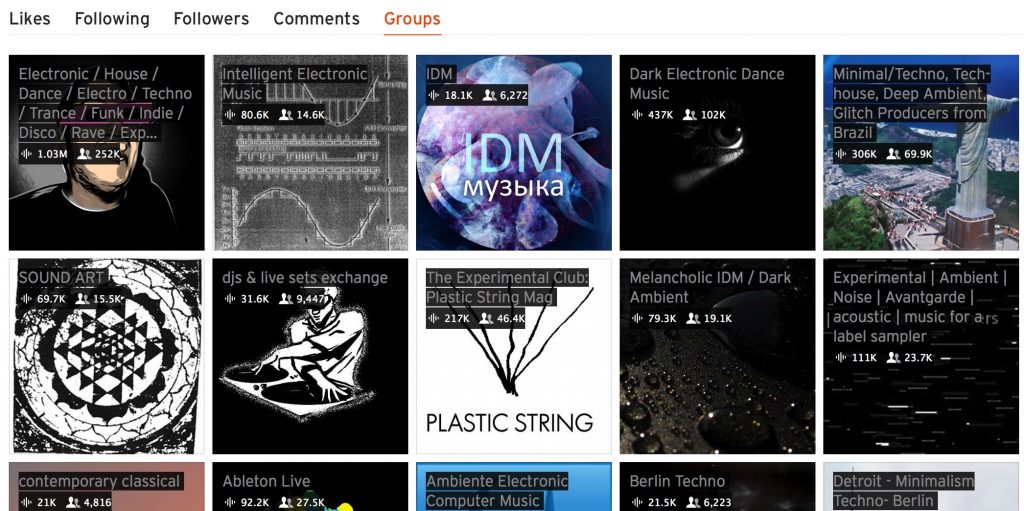
R.I.P., Groups
SoundCloud is taking away groups.
On paper, groups sound terrific. They let arbitrary numbers of users join a collective, share tracks from their own uploads, and gather together tracks from others. There are moderation features, and discussion features.
I heard from several group moderators who got the following news late last month:
We’re constantly looking for ways to make it easier for creators to share their work and connect with new fans. As well as adding new features and updates, we review existing features to see if they’re still beneficial to the community.
As we dug into the best ways for curators to connect with artists and fans, we found that Groups aren’t working as well as reposts, and curated playlists.
With that in mind, we’ve decided to phase out Groups on Monday, August 22nd to make room for future updates. Until then, you can collect, like or repost the content you would like to save, and connect with your fellow Group members.
As a Group moderator, we understand the following you’ve built by moderating submissions to your Groups — we suggest to keep that following going by creating a profile to curate. You can use Reposts and Playlists to share suitable tracks, and accept submissions via Messages.
We’d love to hear your thoughts on how we can continue to improve your experience on SoundCloud. Send your ideas and feedback by replying directly to this email.
The letter from SoundCloud already contains an acknowledgment that something is being lost here. The simple fact of the matter is, Groups are the only way on SoundCloud to allow people to freely add to a playlist. They’re also the only means of hosting a discussion on the site.
On the other hand, that also suggests why you might want to kill groups. Any playlist with open submissions is an invitation to spam. And while native discussion is a nice feature, it’s not so well integrated with other functionality on the site – and duplicates many, many other communication platforms elsewhere. (Hell, you could use an IRC channel if you really wanted to, kids.)
One of the best uses of Groups I’ve seen is moving through the transition without issue, and that’s the amazing collaborative Junto music- and sound-making group hosted by Disquiet and Marc Weidenbaum. Marc had already cleverly moved discussion to a well-organized group on chat platform Slack, and says he’ll simply adjust the workflow to playlists to account for the change. If this matters to you, it’s well worth reading his whole post:
Disquiet Junto After the End of SoundCloud Groups
Marc also shared this on my Facebook page (in a public discussion):
The Disquiet Junto (238 weeks straight, 5700 extant tracks, 650 active accounts, 2000+ members, 1000+ email-list subscribers, 100+ members of the Slack, really nice write-up recently in The Wire) was founded in January 2012 on the Groups interface. I was disappointed when the Discussions tab closed down, but then again there was a major upgrade when Playlists were able to collate tracks outside your own account, and in many ways Playlists are more central now to the Junto than the Groups functionality is. (Also, Reposts were a nice addition, though sometimes I’d like the option to mute them.) I wrote a bit about my thoughts this morning at the URL below. Short version: I think this is gonna especially hit hard those Groups that are focused on particular hardware or software. The Junto, I think less so. With the Junto, as long as folks can let me know they’ve uploaded a track, I can make a playlist of the project. I’ll learn as we proceed up to and after the August 22 transition.
Dylan Davis, meanwhile, moderator of a group dedicated to acid patterns (which can be reproduced on 303 hardware or emulations), had a less optimistic take. He describes groups as a “shared space” lost with the change to the service.
Still, while this may seem an anti-creator decision, prolonged discussion with people using groups found that by and large they were able to migrate to other solutions, including on SoundCloud.
Which brings us to the “giveth” territory.
You can add albums now
Making an “album” on SoundCloud is dead simple. You just take a playlist, then tick a box saying it’s an album (and enter release date and any other relevant metadata).
It’s small, but hugely useful. I know a lot of people have been confused by my own SoundCloud site, because they couldn’t quickly separate random sound content from actual album releases – meaning they couldn’t get a feel for who I was as a musician. (And I think I’m not alone.)
Also, it’s worth comparing just how easy this is relative to releasing music on Spotify or Apple Music. Only YouTube really compares, and that’s itself a bit absurd – it’s a video site, and not suited to the job. (Again, Bandcamp is great, but Bandcamp lacks playlists, or the ability to release audio that isn’t an album.)
Here’s how it works:
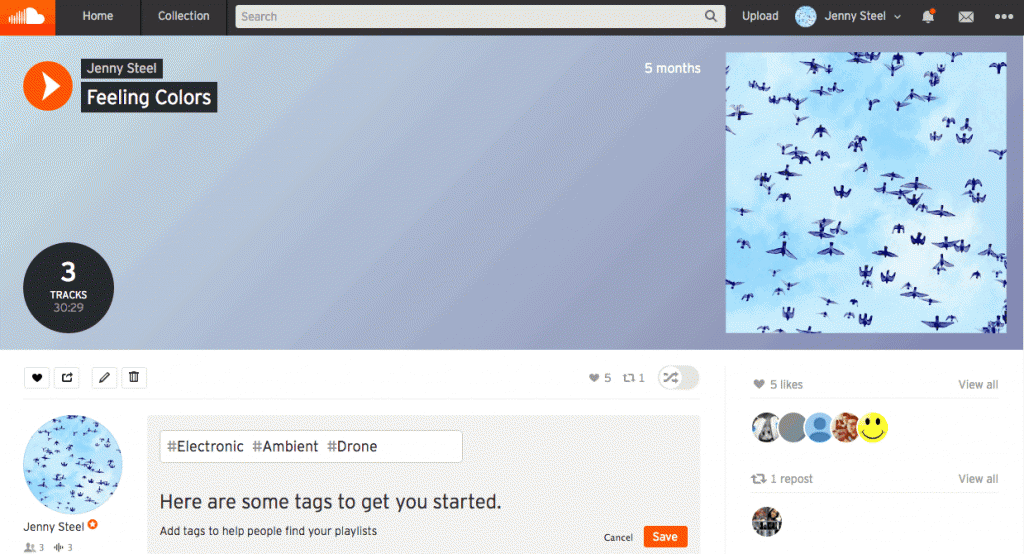
This also makes a difference when listening on mobile, because it’s easier to find album releases. And that’s a necessary prerequisite if people start to use SoundCloud in place of services like Spotify and Apple Music, to listen to actual releases and not just random mixes and whatnot.
That’s obviously partly there for majors, but you can use this, too. There’s no reason you can’t make your own releases and share this way. And there’s still the option to make a ‘buy’ link for downloads, and send people to Bandcamp or Beatport or the like.
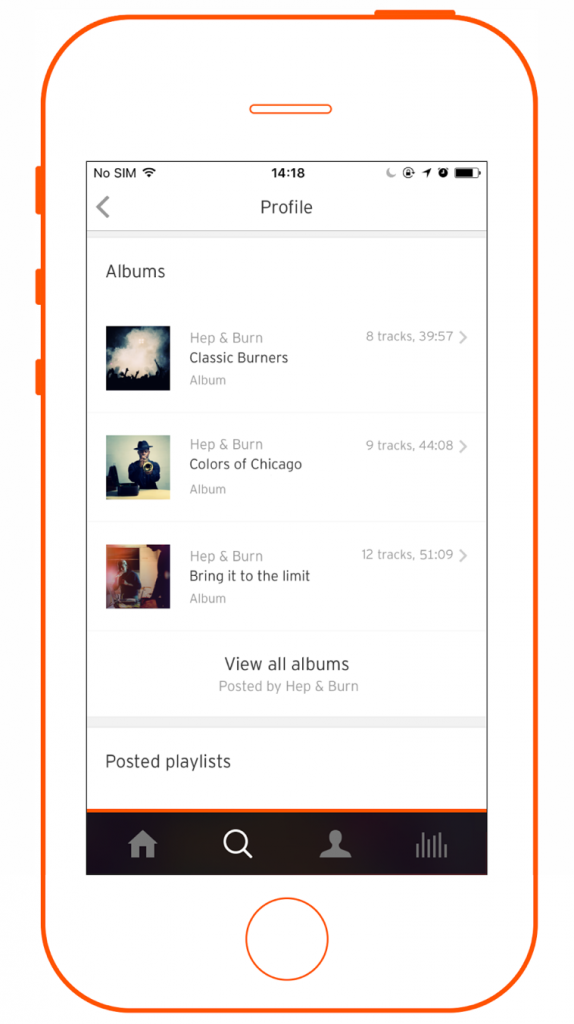
Albums on SoundCloud [SoundCloud blog]
There’s another reason to look to SoundCloud.
Recommendations are really, really good
Okay, to be fair – sometimes, recommendations are predictably awful. But give SoundCloud the right input in the form of a track or mix or album with particularly good keywords, and it can send you down a rabbit hole of discovering great new music. While I love the ability to follow labels and artists on Beatport and Bandcamp, and the ability to see what friends are buying (or getting via free download codes) on Bandcamp’s feed, I haven’t found anything quite as nice as SoundCloud’s recommendation engine. For one thing, not only is it sometimes uncannily good at making interesting connections between artists. And it’ll find really obscure stuff, because of the nature of content on the service.
Plus once you’re there, you can actually favorite tracks and send feedback, rather than just disappear into some metric.
The key to this working the way it does is also the way SoundCloud handles input. Spotify (using I believe a fair amount of data from The Echo Nest) is fairly clever about understanding how music itself is related. But what SoundCloud does is to analyze your plays and (most importantly) likes, to try to produce connections you’ll actually enjoy. And the company says the more you use the service, the better this machine learning gets.
SoundCloud has been putting this recommendation engine forward on both mobile and desktop. Here are some examples.
In June came Suggested Tracks.
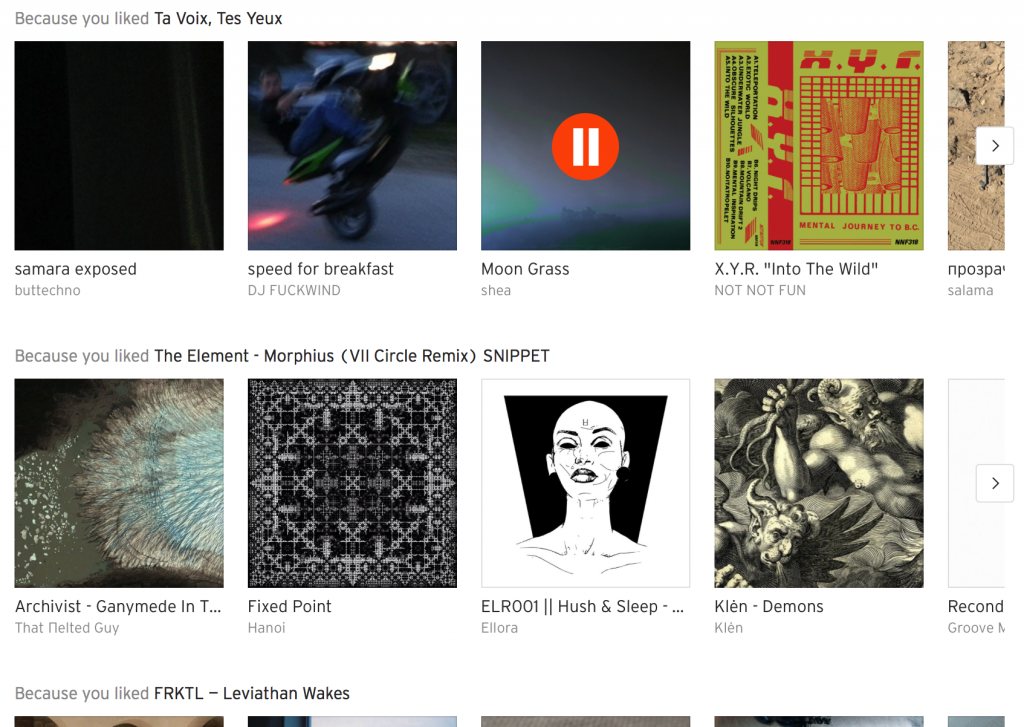
There’s now a Discover tab on the browser app, and a Suggested Tracks section alongside playbacks, plus equivalent sections on the iOS and Android mobile apps accessed via a magnifying glass. The nomenclature is confusing (Discover and Suggested Tracks give you the same choices via a different interface), but the feature is nice.
The supplements something you’ve already no doubt discovered, which is unexpected tracks playing after you finish playing a track you’ve chosen.
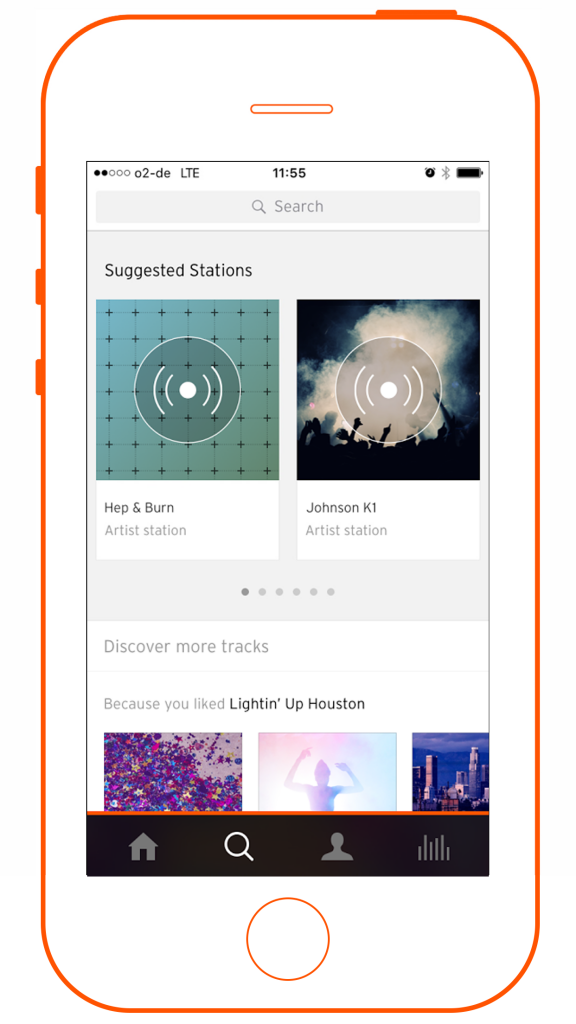
In July, we saw new recommendation functionality rolled into Stations (as seen on various services, most famously on Pandora back in the day). While earlier in 2016 Stations could be launched from a track, now they can be launched from an artist profile – though only in the mobile app, not the browser.
This appears to be a superset of what Suggested Tracks offers. As SoundCloud explains the difference between the two, “Stations serve a longer queue of songs that are a mixture of similar, new, and popular tracks related to the track or artist you started the Station from, for an experience closer to listening to the radio.”
This is licensing-related, too, in that a paid SoundCloud Go subscription expands the number of tracks available.
The Next Evolution of Stations
And you can combine that with the Collections feature already available.
I’ll be honest – I’m rooting for SoundCloud. I’m biased. And I don’t mean I’m biased toward SoundCloud the company, or like the color orange. The thing is, at the moment, there’s nothing with this size catalog, this size audience, this ability for a bedroom producer uploading their first ever track to live shoulder-to-shoulder to a Warner Music artist, this particular set of features – any of it. I’ve seen other tools, and while some of them are compelling, none does quite the same thing. That means if SoundCloud were to meet some demise or find itself under new ownership or leadership, we could really lose something.
That said, you’d do well to keep aware of other options, because there’s no guarantee any private service is going to last forever in precisely the way you’d like.
For now, though, I’ll say this: looking at my SoundCloud collection and the work I’ve been able to discover via the service, I’ve had a uniquely personal experience with the site that has let me get to know lots of artists around the world.
If you want to visit me or send me tracks, I’m at:
https://soundcloud.com/peterkirn